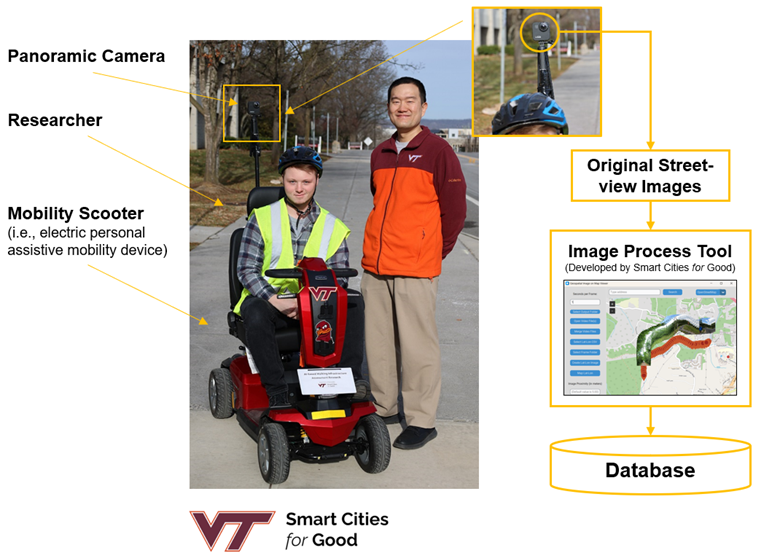Inspired by Work Done at the RPC, a Former Intern Hopes to Bring Valuable New Technology to Communities Around the Country

Thanks to the keen observations of a former RPC intern, it’s possible that certain smart city technologies could soon find their way to areas of the country that have typically not had access to them. And he hopes to include the RPC in that important process.
While doing an internship at the RPC in 2017 and 2018 as part of his post-graduate work for the University of Illinois, Junghwan Kim recognized the immense amount of work that went into the Sidewalk Network Inventory and Assessment the agency regularly completes. Although he did not personally work on that project during his time as a Transportation Planning Modeler, he remembers how the CUUATS team was routinely hiring research interns in the summer months to manually survey and inventory Champaign County sidewalks for walkability and compliance with Americans with Disabilities Act (ADA) standards.
Flash forward a few years and Dr. Kim, now an assistant professor in the Department of Geography at Virginia Tech, wants to use some of the lessons he learned from those observations to bring affordable smart city technology to rural areas and small- to medium-sized cities. These technologies use connected sensors, lights, and meters to collect and analyze data, helping cities improve things like infrastructure and public utilities and services.
“As a researcher, I realized that human-based surveying can be quite time consuming, and MPO’s in small- and medium-sized cities probably don’t have enough resources to be able to hire people to do it,” says Dr. Kim, who holds a Master of Urban Planning and a Ph.D. in Geography from the UI. His experience at the RPC gave him the idea for an AI-based method to make it more cost-effective and efficient for those cities to measure the walkability of their sidewalks.
How will it work? Dr. Kim has developed a mobility scooter equipped with a 360-degree GoPro camera that can be driven by a researcher along sidewalks to provide real-time video images. These images can then be analyzed by researchers to determine walkability and ADA compliance—and would be a faster and far less labor-intensive process than having people walk all the sidewalks in a community.
Titled “Assessing Walkability in Rural Towns and Small Cities in the U.S.: Community-Driven Vision-Language Models for Addressing Spatial Non-Stationarity,” Dr. Kim submitted his proposal for the new technology to the National Science Foundation (NSF) in January and hopes to hear if he will receive funding by Summer 2024. In the meantime, he wants to connect with the local MPO in Blacksburg, Virginia (a much smaller community than Champaign-Urbana), so that he can collaborate with researchers there to determine a workflow for the project. If all goes well, he even hopes to bring the technology to Champaign-Urbana and work with the RPC and CUUATS as one of the program pilots, while continuing to develop more smart city technologies.
“CUUATS is doing a fantastic job with smaller and medium-sized MPO’s around the United States,” Dr. Kim comments. “My graduate research focused on bringing cost-effective, smart city technology to rural communities and medium-sized cities that can be easily implemented. So much research is focused on big cities and major metropolitan areas, which is certainly important, but there is a need to develop technologies for smaller cities and towns because of the large number of elderly people living in them.”
Dr. Kim says his internship with CUUATS was very beneficial and credits it with setting the foundation for him to think about the technologies needed in small and medium-sized areas and his current research at Virginia Tech. This technology he has developed and hopes to expand on will help communities see where their problem areas are regarding sidewalk walkability. Having accurate information about walkability can help cities and towns know where to prioritize sidewalk improvements and give them useful resources for policy recommendations.
He also credits Rita Morocoima-Black, the RPC’s Planning and Community Development Director. “Rita was a great teacher and a great boss,” he says. “I took her class as a first-year grad student at the University of Illinois eight years ago. And while she was my supervisor at the RPC, I thought of her more as a teacher, one who helped me develop the idea for this project. I really enjoyed my time there and have a lot of fond memories.”
Prior to Virginia Tech, Dr. Kim spent time at the Institute of Quantitative Social Science at Harvard University. His works have been published in several peer-reviewed journals and been recognized for several awards. We wish him the best of luck with his proposal to the NSF and his continued work with CUUATS!





